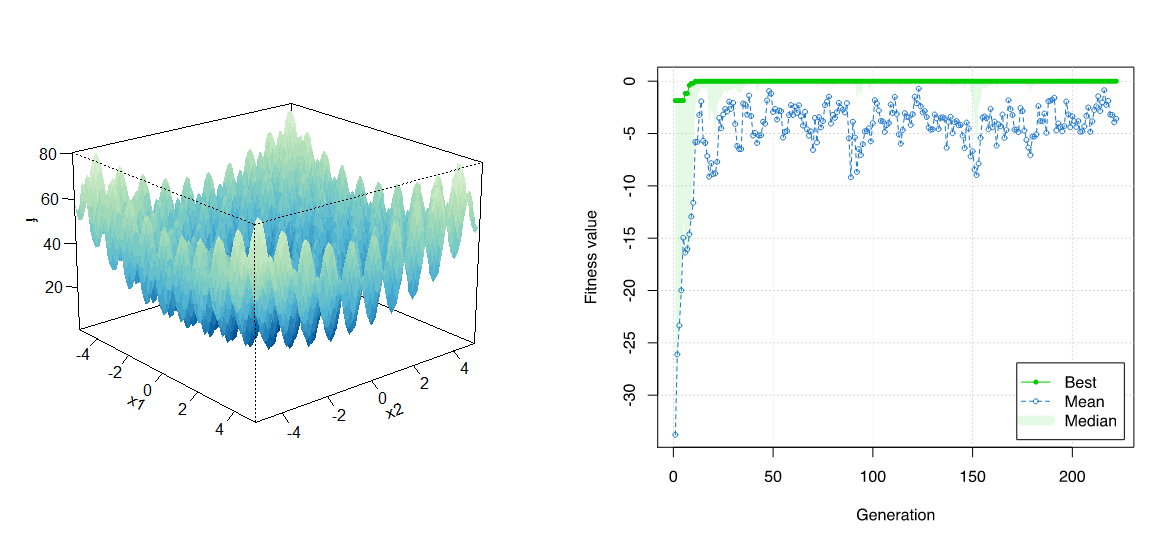I am working with the R programming language. I am trying to learn about different optimization algorithms such as the "Genetic Algorithm" (e.g. A quick tour of GA) vs. the "Evolutionary Grammar Algorithm" (gramEvol: Grammatical Evolution in R | Journal of Statistical Software).
For instance, I can use the Genetic Algorithm to optimize the following function ("Rastrigin") :
#PART 1: Optimize Rastrigin Function with the Genetic Algorithm
library(GA)
#define function
Rastrigin <- function(x1, x2)
{
20 + x1^2 + x2^2 - 10*(cos(2*pi*x1) + cos(2*pi*x2))
}
#plot
x1 <- x2 <- seq(-5.12, 5.12, by = 0.1)
f <- outer(x1, x2, Rastrigin)
persp3D(x1, x2, f, theta = 50, phi = 20, col.palette = bl2gr.colors)
#run optimization algorithm and plot results
GA <- ga(type = "real-valued",
fitness = function(x) -Rastrigin(x[1], x[2]),
lower = c(-5.12, -5.12), upper = c(5.12, 5.12),
popSize = 50, maxiter = 1000, run = 100)
plot(GA)
summary(GA)
Fitness function value = -2.502466e-07
Solution =
x1 x2
[1,] 3.341508e-05 1.203355e-05
 Now, I am using the "Evolutionary Grammar Algorithm" to optimize the same function:
Now, I am using the "Evolutionary Grammar Algorithm" to optimize the same function:
#PART 2: Optimize Rastrigin Function with the Evolutionary Grammar Algorithm:
library(gramEvol)
ruleDef <- list(expr = gsrule("<der.expr><op><der.expr>"),
der.expr = grule(func(var), var),
func = grule(log, exp, sin, cos),
op = gsrule("+", "-", "*"),
var = grule(x1, x2, n),
n = grule(1, 2, 3, 4))
# Creating the grammar object
grammarDef <- CreateGrammar(ruleDef)
#redine the same function in a format acceptable to the "gramEvol" library
Rastrigin <- function(expr) {
# expr: a string containing a symbolic expression
# returns: Symbolic regression Error
x1 <- c(5.12, 5.12)
x2 <- c(5.12, 5.12)
result <- eval(as.expression(expr))
err <- 20 + x1^2 + x2^2 - 10*(cos(2*pi*x1) + cos(2*pi*x2))
return(err)
}
#run optimization
ge <- GrammaticalEvolution(grammarDef, Rastrigin , terminationCost = 0.001)
# print results
print(ge, sequence = TRUE)
There were 50 or more warnings (use warnings() to see the first 50)
Grammatical Evolution Search Results:
No. Generations: 675
Best Expression: log(1) + x2
Best Cost: 57.8494274515718
Question: Can someone please tell me if I have done PART 2 correctly? For some reason, I don't think that PART 1 and PART 2 produced the same answer, nor did they attempt to even solve the same problem. PART 1 actually returns a coordinate of "x1 and x2" that corresponds to the minimum point of the Rastrigin function, whereas I am not sure what the output of PART 2 corresponds to. Is it possible that the "grammatical evolution algorithm" is not a good choice for this problem? Apparently the "grammatical evolution algorithm" is said to work well when the optimization problem has "logical constraints" that can not be specified in the traditional way that "optimization constraints" are usually specified. Is this true?
Thanks!